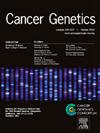TRIM29通过泛素化NEFL和激活PI3K/AKT信号通路促进胶质母细胞瘤的进展
IF 2.1
4区 医学
Q4 GENETICS & HEREDITY
引用次数: 0
摘要
Tripartite motif-containing protein 29 (TRIM29)是多种癌症进展的调节因子。然而,其在胶质母细胞瘤(GBM)中的功能意义仍不明确。在这项研究中,我们研究了TRIM29在GBM中的生物学作用,并阐明了其潜在的分子机制。临床上,与邻近正常脑组织相比,胶质瘤组织中TRIM29的表达明显上调,TRIM29水平升高与GBM患者预后不良相关。在功能上,体外(GBM细胞系)和体内(小鼠异种移植模型)实验均表明,TRIM29过表达可显著增强GBM细胞的增殖、迁移和侵袭能力。在机制上,TRIM29直接与神经丝轻多肽(NEFL)相互作用,触发k48连锁的多泛素化和随后的NEFL[1]蛋白酶体降解。这种泛素化依赖性NEFL下调导致PI3K/AKT信号通路的组成性激活。我们的研究结果揭示了一种新的驱动胶质母细胞瘤恶性肿瘤的TRIM29-NEFL-PI3K/AKT轴,突出了靶向该途径治疗GBM的治疗潜力。本文章由计算机程序翻译,如有差异,请以英文原文为准。
TRIM29 promotes glioblastoma progression via ubiquitinating NEFL and activating the PI3K/AKT signaling pathway
Tripartite motif-containing protein 29 (TRIM29) is a regulator of tumor progression across multiple cancer types. However, its functional significance in glioblastoma (GBM) remains poorly defined. In this study, we investigated the biological roles of TRIM29 in GBM and elucidated its underlying molecular mechanisms. Clinically, TRIM29 expression was significantly upregulated in glioma tissues compared to adjacent normal brain tissues, and elevated TRIM29 levels correlated with unfavorable prognosis in GBM patients. Functionally, both in vitro (GBM cell lines) and in vivo (a mouse xenograft model) experiments demonstrated that TRIM29 overexpression robustly enhanced GBM cell proliferation, migration, and invasive capacity. Mechanistically, TRIM29 directly interacted with neurofilament light polypeptide (NEFL), triggering K48-linked polyubiquitination and subsequent proteasomal degradation of NEFL[1]. This ubiquitination-dependent NEFL downregulation led to constitutive activation of the PI3K/AKT signaling pathway. Our findings uncover a novel TRIM29-NEFL-PI3K/AKT axis that drives glioblastoma malignancy, highlighting the therapeutic potential of targeting this pathway for GBM treatment.
求助全文
通过发布文献求助,成功后即可免费获取论文全文。
去求助
来源期刊

Cancer Genetics
ONCOLOGY-GENETICS & HEREDITY
CiteScore
3.20
自引率
5.30%
发文量
167
审稿时长
27 days
期刊介绍:
The aim of Cancer Genetics is to publish high quality scientific papers on the cellular, genetic and molecular aspects of cancer, including cancer predisposition and clinical diagnostic applications. Specific areas of interest include descriptions of new chromosomal, molecular or epigenetic alterations in benign and malignant diseases; novel laboratory approaches for identification and characterization of chromosomal rearrangements or genomic alterations in cancer cells; correlation of genetic changes with pathology and clinical presentation; and the molecular genetics of cancer predisposition. To reach a basic science and clinical multidisciplinary audience, we welcome original full-length articles, reviews, meeting summaries, brief reports, and letters to the editor.
 求助内容:
求助内容: 应助结果提醒方式:
应助结果提醒方式:


